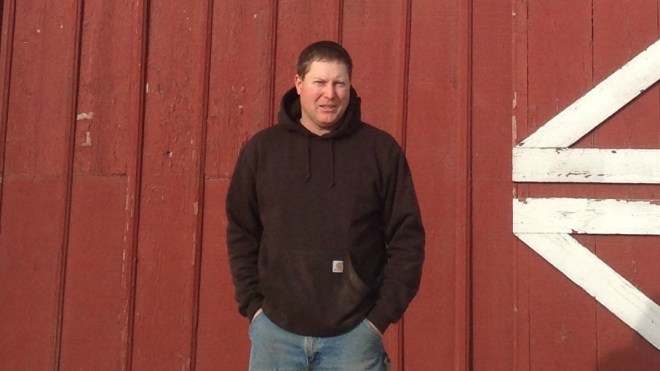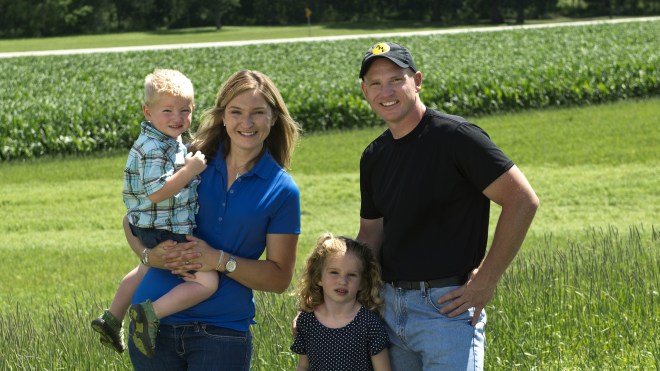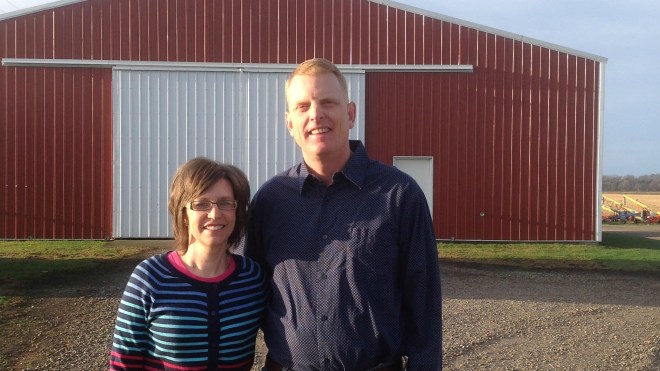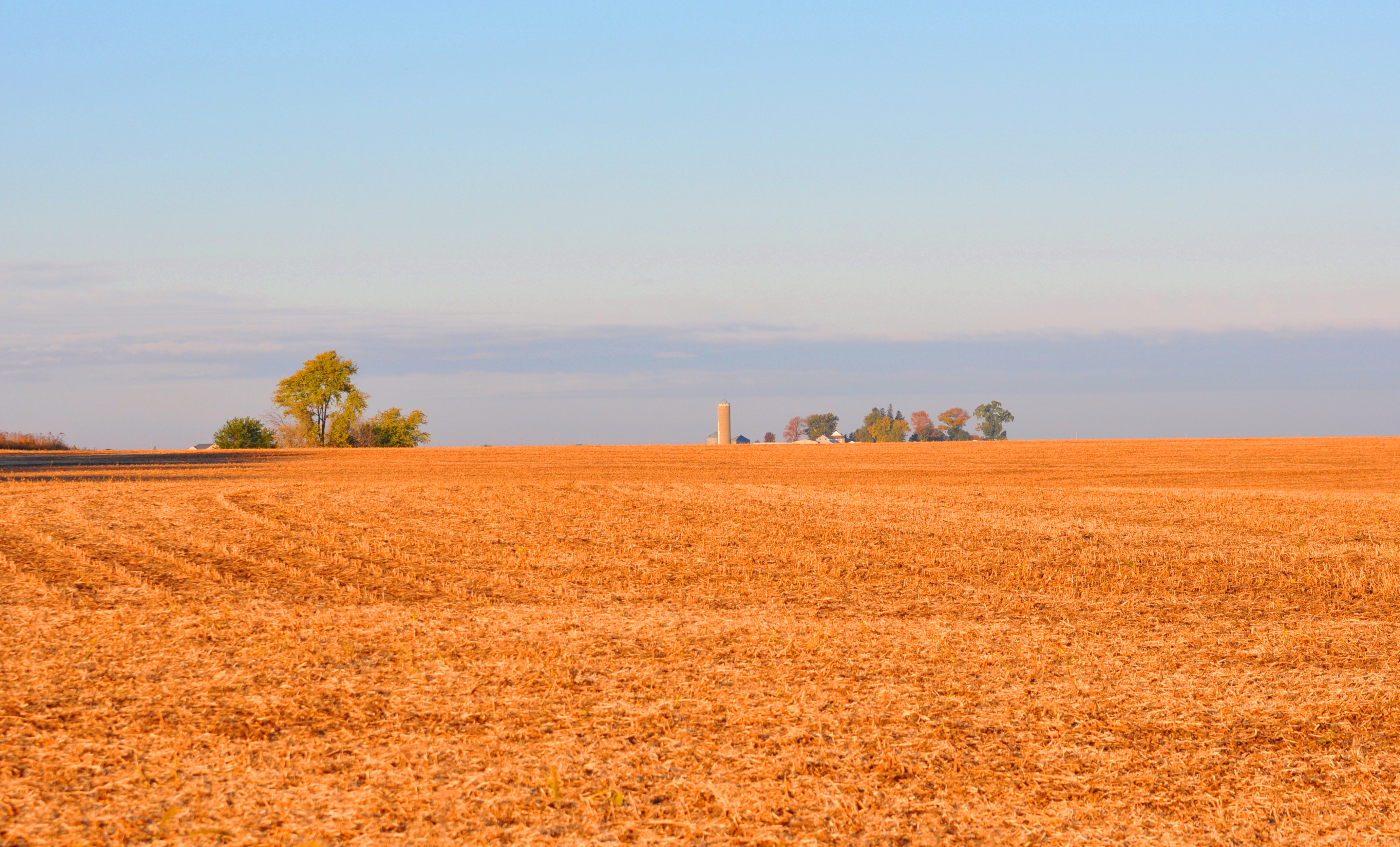If you’ve ever crossed Iowa on I-80 en route to someplace you fancy more exotic, you might recall mile after solitary mile of soybeans and corn and the occasional side-leaning barn. Agriculture, you may have noticed, is Iowa’s most palpable characteristic — but, I’ll wager a guess, you didn’t see more than one or two farmers anywhere in sight.
Even as a small-town Iowa kid, the only farmers I knew personally were my great-grandparents — who, in their heyday, were known state-wide for their prize-winning watermelons. Iowa has undergone a lot of changes since Grandpa Clyde was grooming his gourds, though. In 1950, the state had 206,000 farmers; in 2012, that number was down to 88,637. Iowa land once cultivated a diverse range of crops, but is now seeded almost exclusively with commodity crops like corn, soybeans, and oats that are processed into ethanol or animal feed. Tell me where you can find a watermelon farmer in Iowa now, let alone a famous one, and I’ll buy you one of those blue-ribbon tenderloins.
[grist-related-series]
A few months ago, I traveled home to visit family. Flying from Seattle to Des Moines, I watched the landscape shift from snow-capped mountains to carefully gridded squares. From above, Iowa appears to have been meticulously engineered into one, big corn- and soy-producing machine. Though I was there for mom and dad, I was also on a quest to find my home state’s hidden farmers. After 23 years as an Iowa kid, I’d finally meet the farmers behind those fields, the inconspicuous backdrop to my childhood.
Really, I did more than just meet them. I chatted about agricultural policy over cinnamon-spice tea; toured a thousand-acre farm in a fourwheeler seated next to a labrador; and played peek-a-boo with shy, barefoot farming boys.
Iowa commodity growers are often demonized for what and how they grow, and monocultures and ethanol aren’t exactly healthy for the planet. But all of the farming families I talked to expressed a deep respect for the land and the desire to take good care of it for the next generation. If we want to understand how and why our agriculture system is the way it is, we’d be wise to approach all farmers with an open mind.
So, meet a few of Iowa’s farmers. Here are our edited and condensed conversations:
Brock Hansen

Liz Core
Farm stats: 2,300 acres of corn and soybeans in Baxter, Iowa
What’s the history of your farm?
On my mom’s side, our land goes back five generations. We strictly grow corn and soybeans, along with a small amount of alfalfa. My mom and dad have their own operation, and my wife and I have our own operation — but we work together. Until about 10 years ago, we had beef cows, and sold the calves off in the fall. Dad sold seed corn on the side. Since then, we got out of hogs and cattle. We had a hired man who stepped in and took over. When we sold the hogs, we bought a few semis and hauled grain and bean meal out of Des Moines to a chicken farm.
How do you sell your product?
First, I look up who has the best prices and contracts. Almost 99 percent of our corn goes to ethanol plants, and the byproduct is turned around and fed to livestock. One hundred percent of our beans go to Des Moines for oil and meal production. Have you heard of Unilever? We’re participating in a program so we can trace where the beans come from and what’s being done to them. I think a lot of them go into Hellman’s mayonnaise.
How has your farm changed?
In granddad’s era, the new thing was chemicals — that was probably in the ’50s or ’60s. Then it went to commercial fertilizer and no-till farming in dad’s era. Now, in my era, the newest part is GPS equipment, pin-point location, and all the technology that’s been brought to the farm. Farming is more of world market than it’s ever been. The market used to never move — if there was a $0.10 swing, it’d take years. Now, that’s an everyday thing.
What do you see as the future of your farm?
Who’d a thought 20 years ago we’d have tractors that would drive themselves? Everything gets bigger, it seems like. Is it the best for it? Probably not. People used to live off of 160 or 180 acres — I wish it could go back there. The world might be better, in general, if farming went back to the mom-and-pop shops.
Do I want to get bigger? Well, everyone wants a bigger piece of the pie. I’d like to be the most efficient on the acres I have. But I don’t need 20,000 acres when I can be just as productive on 5,000.
In what ways are the goals of the food movement consistent with the goals on this farm?
I don’t see the consumer, to tell you the truth. It’s a closed circuit for me. I take our grain straight to the ethanol plant. But you know, consumers are asking them for non-GMO bean meal to feed non-GMO pigs at the company we haul our beans to. There’s a growing demand for that. But you as a consumer, and me as a producer, our paths don’t usually cross.
When the consumer asks us what we’re doing, I tell them we’re trying to be better. I don’t think our story is told enough, but we’re trying. I blame some of that on the media — no offense. It’s easy to cover the bad things, not the good things. For instance, we’ve been no-till for 25 or 30 years, which helps with erosion and creates better top soil; we’ve introduced cover crops; we use GPS equipment to help minimize over-use of chemicals; we’ve upgraded grain driers; we applied for an energy grant to make the drier more efficient, to use less natural gas; we’re looking at putting up a wind turbine. We’re trying to be environmental, green — whatever you call it.
Mark and Julie Kenney

Julie Kenney
Farm stats: 3,000 acres of corn, soybeans, and oats in Nevada, Iowa
What’s the history of your farm?
Mark: We’re fifth-generation farmers. My great-great-grandfather started farming in central Iowa back in the 1880s. The original parcel of land that he purchased, we still own. Generations have added to it, but I’m proud that original piece is still a part of our family farm.
Julie and I make our livelihood on this farm. Where I go to work is where I grew up as a child. I feel really fortunate. As a duty, as a responsibility, we try to be active in promoting agriculture to those who aren’t involved in it. We invite people to our farm to show day-to-day operations. When it becomes more of a conversation, commodity farming becomes more readily understood. It takes time, but it’s just as much as the job as making sure the crops are planted.
How has your farm changed?
Mark: My dad says he remembers the first commercial seed he planted. It was planted by a two-row, horse-drawn planter. The last crop he planted was with a tractor driven by GPS.
One thing that is the same today as it was generations ago is that we’re producing a commodity, so our competition isn’t only local, it’s global. Technology isn’t something to be shunned or afraid of — it’s to be embraced. We need to find ways to use new technologies to make our farm competitive in world markets. I’ve always been taught that technology can give you an edge.
Julie: The thing I’ve seen change the most is how public perception is influencing what we do. In Iowa, more and more young people are removed from the farm. So now, we have a duty to help open doors to explain to others who aren’t as familiar with what’s going on. I try not to think of it as us educating, because I want it to be a two-way conversation; I want to listen to what the general public’s concerns are.
What do you see as the future of your farm?
Mark: The way my grandpa farmed is different from the way we farm now, but there are certain things that endure time. While the equipment has changed, the core values are the same: attention to detail, being fiscally responsible, understanding that there’s more to the world than just yourself, being a member of the community, and making yourself available to help neighbors in need. That’s what I hope will continue on this farm.
Agriculture will keep getting more competitive and capital intensive. I estimate farms will become larger because technology is allowing that, and we’ll continue to produce more from a smaller resource base.
Julie: I think there will be more non-traditional people who get involved in farming. I think we’ll see more companies like Google that want to be involved in agriculture. I think we’ll continue to get questions from people about where their food comes from, and we’ll have to become more transparent about that.
In what ways are the goals of the food movement consistent with the goals on this farm?
Mark: Above any other law, my No. 1 boss is Mother Nature. The weather is in control — and such a major factor in our yearly income. It impacts if we can work some days. It’s been true since the dawn of time, but it’s still one of the biggest misconceptions in modern agriculture.
I think I can speak for most farmers and say that we enjoy our independence. A trait that successful farmers share is operating our farms the way that we please. For instance, a mile from our house is a small organic farm with vegetables and honey bees. They have a very small acreage, and it’s a lot of labor — but they’re doing it. Another farmer next to us grows organic corn and soybeans. We’re all farmers, it’s all agriculture, we just all do it a little different.
How does agricultural policy affect you?
Mark: Our farm has operated under the auspices of farm bills since the 1930s. I don’t see how that is going to change how we work on the farm. Government doesn’t outweigh market forces — and it certainly doesn’t outweigh the weather. I do think there’s a role for the government to play in food production. Of all the things we must secure, food is No. 1. We wouldn’t want to outsource our food production like we’ve done with energy production — what a terrible thing that would be.
Ward and Sandi Van Dyke

Ward Van Dyke
Farm stats: 2,000 acres corn and soybeans in Pella, Iowa
What’s the history of your farm?
Ward: We’re third- and second-generation farmers, but we’ve had this farm since 1986. There would be days in high school when I would skip school to help with the crops. Back then, that’s just what we did.
Sandi: We started in cattle and hogs and eventually we went strictly to grain. When we moved here, we added a garden as a project for our kids.
How has your farm changed?
Ward: When I was little, my parents had two- or four-row planters. Now, we can plant 30 rows at a time, and that’s just average — it’s actually kind of small. Our combine harvests with a 35-foot head, rather than 16 like it used to be. We went from having no technology to having full auto-guidance, automatic sprayer shut-off, yield monitors, variable rate planning, and variable rate nitrogen application.
That technology makes us much more efficient. For example, when we’re out in the field planting seeds, we want to know what’s been planted. The machine will shut off so we don’t plant more seeds than we need. Same with the sprayer: It’ll shut off so we don’t put out too much herbicides or insecticides.
What do you see as the future of your farm, and farming in Iowa?
Ward: In general, farms are going to continue to get larger. If labor is an issue, you can eliminate people, and tractors do it.
Sandi: I don’t know, sometimes I wonder. There’s been an influx of smaller, niche farms. I don’t know if the general public will catch on and embrace it, though, because we’re used to cheap food. Everybody wants cheap food.
Ward: You wouldn’t have the critical mass for that. It’s hard, it’s tough.
Sandi: It would be fun to go back, though. Wouldn’t it be nice to go back to how it was when we grew up our parents’ farms? There was livestock, chickens, and grain — it was more self-sufficient. It’d be nice.
How does agricultural policy affect you?
Ward: I’ve been to two meetings already to talk about the farm bill — and it’ll take a meeting or two more before I understand it. The policy is complicated. In general, I think less government is better. There are a lot of hurdles to jump over, paperwork, and time and energy and money, versus just doing what we need to do. Why make it so complicated?
In what ways are the goals of the food movement consistent with your goals on this farm?
Ward: We don’t want our grain hauled any farther than it has to — similar to the farm-to-table movement. The fewer miles the grain has to drive is better, because it’s expending less fossil fuels.
And there’s also a lot of consumer education that needs to happen around here. You know, in our kids’ garden we have these great spaghetti squash, but if consumers don’t even know what a spaghetti squash is, then what? You have to educate consumers, so they want to buy the product.
Sandi: We used to have a CSA, but lots of people quit because they weren’t using all the produce. People are in so many activities and always on the go, so they aren’t able to prepare their own food. It’s interesting; there are so many people who think they want to do eat local until they have to implement it. And they can’t, because it doesn’t fit with their lifestyle.


